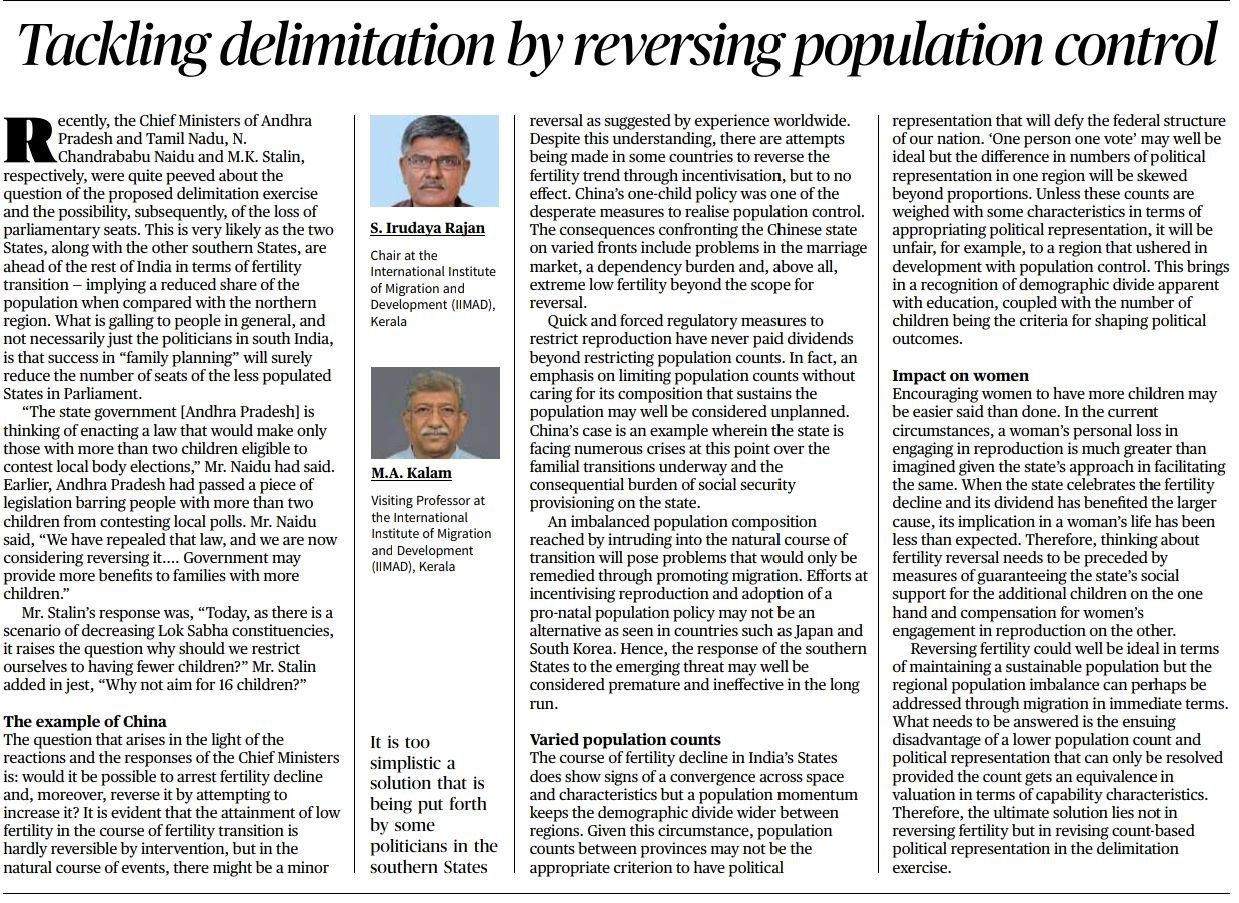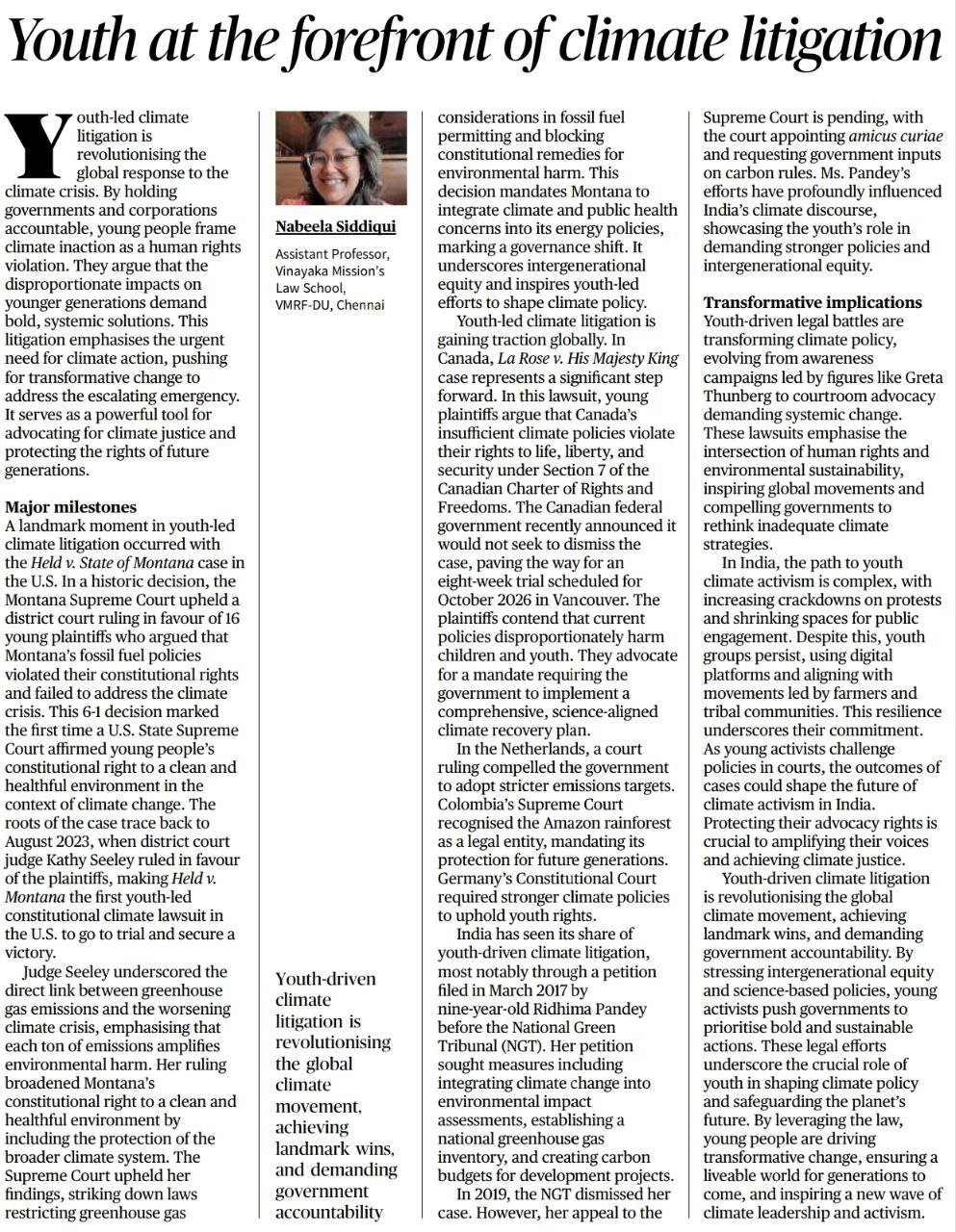1. Addressing Delimitation Challenges Amid Population Control Policies
Introduction
- Delimitation in India refers to the process of redrawing parliamentary and assembly constituencies based on population changes to ensure equal representation.
- The recent debate centers around the perceived disadvantage to southern states due to their success in population control, potentially reducing their parliamentary representation.
- Core Issues
- Population-Based Representation: The southern states’ success in family planning contrasts with higher fertility rates in northern states, creating an imbalance in parliamentary seat allocation.
- Policy Reversals: Proposals like Andhra Pradesh’s suggestion to incentivize larger families reflect concerns about maintaining representation.
- Federal Structure at Stake: Unequal representation could disrupt the principle of “one person, one vote,” causing regional disparities.
- Case Studies
- China’s One-Child Policy: Demonstrates the challenges of reversing fertility decline and its socio-economic repercussions, such as dependency burdens and low birth rates.
- Japan and South Korea: Efforts to incentivize higher fertility through social and economic measures provide alternative approaches but with limited success.
- Alternative Solutions
- Promoting Migration: Balancing regional population disparities through migration rather than reversing fertility trends.
- Equitable Representation: Redefining criteria for political representation by considering factors like education and number of children.
- Women’s Empowerment: Policies must address the socio-economic implications for women to encourage larger families, including enhanced state support for childcare and compensation.
- Long-Term Implications
- Social Equity: Ensuring fair political representation and economic support systems without disrupting natural population transitions.
- Policy Prioritization: Focus on sustainable development, better education, and healthcare instead of incentivizing larger families.
Conclusion
Reversing fertility trends is not a viable solution to address the political representation concerns arising from population control. Instead, the focus should be on fostering migration, redefining representation metrics, and ensuring socio-economic balance. These measures will help uphold the principles of equity and federalism while addressing regional disparities.
Mains Practice Question |
Q. Critically analyze the challenges posed by population-based delimitation in India, especially concerning the southern states. Suggest sustainable alternatives to address these challenges. |
2. Youth as Catalysts of Change in Climate Litigation
Introduction
- Youth-led climate litigation is reshaping global climate governance by holding governments and corporations accountable for inaction.
- These movements emphasize the disproportionate climate impacts on younger generations, advocating for systemic solutions and transformative change.
- Landmark Milestones
- S. Case: Held v. State of Montana
- First U.S. constitutional climate lawsuit where youth plaintiffs secured recognition of their right to a clean and healthful environment.
- The court highlighted the link between greenhouse gas emissions and climate harm, urging policy reforms.
- Canada: La Rose v. His Majesty the King
- Youth plaintiffs argue for stronger climate policies aligned with constitutional rights, marking a significant step toward intergenerational equity.
- Global Examples
- Netherlands: Court mandated stricter emissions targets.
- Colombia: Recognized the Amazon rainforest as a legal entity to safeguard future generations.
- Germany: Constitutional Court mandated robust climate policies to uphold rights.
- Indian Context
- Notable case: Ridhima Pandey’s petition (2017) to the National Green Tribunal (NGT).
- Called for integrating climate considerations into policies and reducing emissions.
- Amplified youth-led advocacy in India, demanding intergenerational justice.
- Transformative Implications
- Intergenerational Equity: Youth-driven actions push for climate justice for future generations.
- Governance Shifts: Courts are increasingly aligning energy policies with climate and public health needs.
- Amplifying Advocacy: Platforms like Greta Thunberg’s movement empower youth globally to demand accountability.
- Challenges and Way Forward
- Legal battles often face prolonged litigation, resistance from stakeholders, and limited policy implementation.
- Strengthening laws and creating enabling environments for youth participation can foster transformative change.
Conclusion
Youth-led climate litigation symbolizes a paradigm shift toward accountability and sustainable policies. By leveraging the law, young activists are spearheading a global movement for climate justice, ensuring a sustainable future for all generations.
Mains Practice Question |
Q. Youth-led climate litigation is becoming a powerful tool to address climate change. Discuss its impact on global and Indian climate governance, highlighting key challenges and solutions. Bottom of Form
|



